醫學科技的發展,延長了人類的平均餘命,使得「長壽」逐漸成為常態。隨著社會變遷與人口結構的改變,「高齡化」逐漸成為全球趨勢與各國關注的焦點。對現代社會而言,不管是將「老年」視為生命週期進展的一部分來思考與探究此階段人口在社會所扮演的角色,或從醫學、社會科學等面向研究「老」的生理、心理變化與需求,甚至對於高齡人口社會福利與醫療照護系統與政策規劃的發展,都是十分近代的產物。
尤其,當戰後嬰兒潮世代進入老年期,其「老化」的過程、需求及其意涵便成為現代社會不同世代探討與面對未來不可迴避的課題。例如,近年來成人教育學家Edward Kelly推動的「第三人生」(The Third Act)的概念,即重新調整人生階段發展目標的分期,將人生下半場定位為總結成長期與成家立業期的社會參與以及回饋階段。在高齡人口比例逐漸增高的現代社會中,如何一方面回應人口老化衍生出的各種需求,一方面發揮與創造「老年」的價值,已經成為一種新的文化運動。
臺灣社會也正逐漸從高齡社會邁向超高齡社會,推估到2025年時,老年人口比率將超過總人口的20%。換言之,我們的社會從來沒有這麼老過,也未曾老得如此快速過。然而,我們的社會對於重新思索與定義「老年」、談論「老後人生」可能性的各種探索行動仍然充滿侷限、焦慮與不安。
臺灣避談老後人生的重要原因之一在於因為將「尊老盡孝」的養老文化價值觀視為習以為常,理所當然。而另一方面,由於在臺灣社會文化脈絡下,討論「臨終死亡」常常被視為「觸霉頭」甚至禁忌的「沈重」話題,也成為跨齡或代間討論有關人生「晚年」的隱性障礙。
尤其在背負臺灣社會老年贍養主要責任與文化期待的「家庭」養老功能逐漸弱化時,「變老」不再只是指涉生命階段的成熟老化狀態,而是一種社會需要面對與處理的「問題」。尤其,當政府以長照資源建置與政策施行來因應高齡化社會不同的「老」所帶來的挑戰,也映照出臺灣社會在都市化、少子化等社會變遷因素的交互作用對於「安老」的衝擊。
然而,當臺灣社會訴諸問題解決導向的決策與行動來因應變老帶來的各種挑戰時,聚焦老年處境的大眾媒體論述與報導逐漸將「銀髮族」視為一個整體,並與其他組成社會的「族」做區隔。儘管人生階段中的老年時間延長使得老的樣態更加多元也充滿異質性,但長者如何理解自身所處社會老年文化價值的探索過程,仍受社會整體如何建構、想像與面對「老」的影響。而人們對於「變老」狀態的定義、理解與調適,是透過不斷建構「老年」的定位與價值以及調整自身生存策略的狀態而呈現於世。
在此脈絡下,探究人類處境複雜脈絡的人類學視野對於理解不斷變動中的老年文化意涵提供了重要的視角。人類學視野下的「變老」,除了是生理、身體上的成熟發展與變化過程,也是一個社會文化族群親屬關係、資源分配與社會網絡的實踐與調適過程。而探索老年讓我們不但得以窺見過去到現在自我發展的過程,以及一個社會的人觀(意指一個社會對於「人」的觀念與想像)。
因此,筆者認為我們在找尋老年議題的各種創新解方前,回到「人」的根本探索與反思人的價值以及與社會的連結關係是看見老年文化多元意涵的開始。劇場和人類學同樣都以「人」為關注的焦點,都在回應「人」的各種現象與問題,並探索可能的出路。
本文爬梳目前臺灣應用田野方法展演老年的戲劇與劇場發展模式。筆者認為,關於老年議題,現今應用戲劇與劇場領域的發展對於如何回歸到對於人組成的社會文化脈絡來著力,思考解方,提供了一種新視角:把「變老」當作是一個持續變動與發展的「田野」來思考其中的文化與自己,挖掘形塑老年的文化脈絡,試著從文化整體觀的角度來創造跨齡對話的連結則是理解「老年」文化意涵的關鍵。
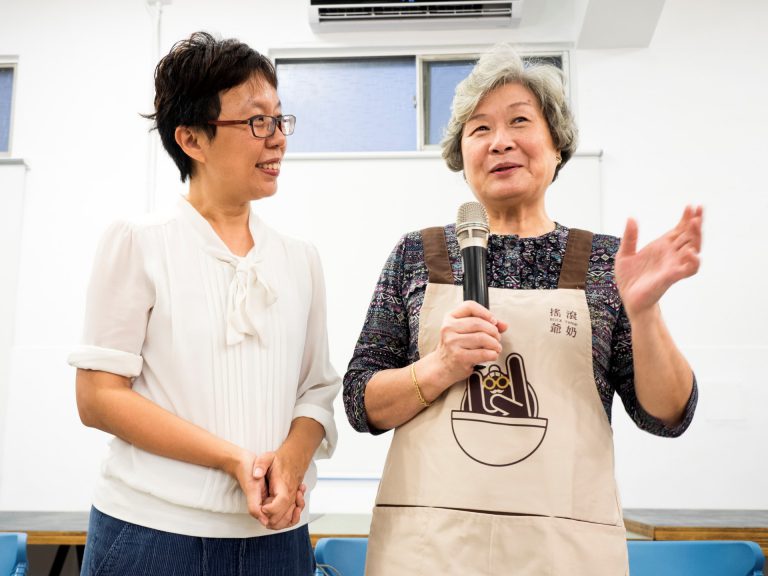
人類學家常以「田野」來描述所觀察對象生活的時空。從中西戲劇與劇場發展的歷程與脈絡可以發現劇場作為一個人與人相遇集結的空間,提供了體現、凝聚與創造過去、現在與未來社會意義的多元詮釋與可能性。換句話說,劇場與田野調查著重在蒐集與描繪一個族群日常生活與社會場景的田野調查方法有許多共同之處。
1978年,具有教育戲劇背景的劇場導演Stuart Kandell在美國加州奧克蘭市的老人活動中心開設給長者的即興戲劇課程,以所蒐集的長者生命經驗故事作為題材,邀請長者參與並在許多地方巡迴演出,以劇場即興互動作為社會融入的方式開啟了美國老人劇場(Senior Theatre)發展之路,因而被認為是活躍老化領域的先驅。
而英國的歲月流轉中心(Age Exchange Reminiscence Centre)導演Pam Schweitzer則招募專業年輕演員以口述歷史方法開採長輩的生命敘事編輯成為劇場演出內容,其1993年成立以熟齡演員為主的老人回憶劇場(reminiscence theatre)至今仍發揮重要影響力。1 2012年起,英國Keely University與擅長社會紀錄劇場的the New Vic Theatre開始合作的「年齡與舞台」(Ages and Stages)專案計畫,則是根據蒐集在地居民對於當地社會經濟政治變遷記憶、老年人口生活歷史再現以及訪談步入老年的劇場相關人口等田野調查資料後,推出由劇場工作者與受訪長輩共同展演的《我們的年齡,我們的舞台》(Our Age, our Stage)紀錄劇場作品來呈現老化、代間關係與劇場對當地高齡人口的意義,並延展成為戲劇展演與老年文化動力的研究成果。2
在臺灣當代劇場發展歷程中,以熟齡長者為主要成員的正式劇團組織則主要被歸類在社區劇場的範疇,其中較知名的「歡喜扮劇團」目前處於休團階段,過去的演出以口述歷史劇場為特色;而仍然活躍的臺南「魅登峰劇團」成立於1992年,是臺灣第一個以四十五歲到八十歲的熟年團員組成的老人劇團。舞台上的年長演員一方面透過自身生命經驗的分享創造自身與社會的連結,一方面藉由透過展演高齡長輩在地歷史與生活記憶表述生命情感的意義與價值。
除此之外,專業劇團與社會組織的合作、大學應用戲劇相關科系師生以及校園外的臺灣應用劇場發展中心成員則是近年來透過計畫或專案社區田調設計過程,將長輩從觀眾變為舞台主角的重要推手。
例如果陀劇場與新光人壽慈善基金會合作超過十年的「活化歷史」公益方案,則是基金會從美國「長者分享藝術」(Elders Share the Arts,ESTA)機構引入臺灣,透過「生命劇場」的藝術文化形式,讓長者以口述歷史方式重現生命故事與價值,幫助孩童重新認識「老」的價值與印象。許瑞芳教授在臺南嶺南社區與當地老年居民發展出的《嶺南聖戰》、思樂樂教育劇場於臺北公館蟾蜍山的計畫引導在地長者以社區劇場來分享生命記憶,或者陳韻文教授在「夏日首陽.戲劇楊逵――戲劇教育×導覽種子」計畫中,為臺南新化的楊逵文學館培育當地樂齡長者成為博物館劇場社群藝術的主要演員並進而成為翌年成立「大目降劇場」之班底等等。
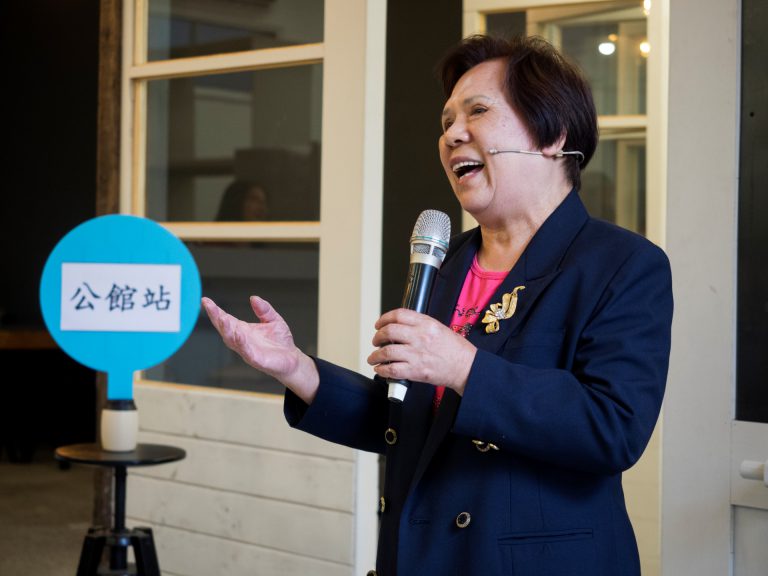 臺灣也有戲劇團體應用田野方法來展演老年的戲劇,思樂樂劇團就應用田野方法與戲劇結合,讓長者演員分享自己的生命故事。圖/許斌攝影
臺灣也有戲劇團體應用田野方法來展演老年的戲劇,思樂樂劇團就應用田野方法與戲劇結合,讓長者演員分享自己的生命故事。圖/許斌攝影
以戲劇展演作為分析社會行為與儀式關係的視角的人類學家Victor Turner即提出族群戲劇(ethnodrama)的概念作為一種以藝術展演為基礎的方法,其聚焦特定族群,讓各種田野調查獲得的資料,透過藝術家轉化成為展演的腳本,來「再現」田野調查對象在社會特定處境中的真實個人故事。而這類作品的意涵除了具有「研究的展演」之特性,同時也有某種帶有「觀眾意識」的劇場性。3
另一方面,包括社會文化老年學研究以及人文藝術等相關領域研究指出,以長者真實生命經驗故事進行展演老年的藝術創作與意義建構過程,除了有助於創造社群歸屬感與建立自身認同以及自我覺察,同時也能體現老年作為生命歷程「發展潛能」之意涵。因此近年來以戲劇表達方案與活動設計作為一種保持長輩身心健康與社會連結的緩和健康照顧與非藥物治療手段,則逐漸成為一種常見的高齡長照服務模式。臺灣失智症協會近年來開始將戲劇治療納入身心健康與療癒的課程方案外,弘道老人服務基金會也在2016年將社區劇場作為一種整合健康促進、懷舊表達與自我賦能的社區據點課程。
劇場展演在社會中受到欣賞、評價與多元的詮釋,創造出一種雙向建構的文化動態空間,觀戲與展演經驗可以映照出參與群體所處共通或不同的社會文化脈絡,同時在這個交流過程中,參與群體也創造並影響著對戲劇與劇場的文化意涵。戲劇與劇場方法綜合藝術形式與感官經驗,透過具象化時空反映文化的多重情境,所以應用戲劇與劇場方法在活躍老化與創意老化概念的發展過程中,成為一種以表達性藝術對話與理解以及深化老年生命意涵的「介面」。在戲探老年的不同模式,提供我們對於戲劇與劇場如何體現社會性的一種視角。
而從以上各種以展演老年生命歷程作為舞台聚焦主體的戲劇與劇場活動中,田野調查不只是開採長者生命經歷的工具,更重要的價值在於讓戲劇與劇場方法的應用有所本,透過使其得以創造人際與群體關係的連結,邀請社會參與或發揮療癒與建立認同的力量,彰顯其社會性的功能與價值。
筆者認為應用戲劇與劇場方法作為老年文化田野調查工具最大的特色在於創造出一個在虛實之間交織出的展演空間,讓在場觀眾得以藉由卸除與轉換原生社會角色,在參與建構創造戲劇角色的過程中,一方面應用戲劇構築的儀式過渡空間內部秩序自成一格的特性,映照與反思原本自身所處世界「理所當然習以為常」的自我認同,進而對關注議題產生多元而立體的理解;另一方面在入戲出戲之間體驗到想像力、換位思考背後文化脈絡的作用力。
如同關注現代戲劇如何展演老年的表演研究學者Valerie Barnes Lipscomb曾經以莎翁名劇《哈姆雷特》(Hamlet)的臺詞「戲劇是關鍵」(The play’s the thing)作為隱喻,強調戲劇方法對於老年研究田野資料的蒐集與產出是十分具有啓發性與生產性的工具:其不只是文本與舞台展演讓老的多元性與異質性具體化的過程,同時也是挑戰社會老年刻板印象文化脈絡的思考工具。4
除了奠基於田野調查研究來展演老年文化的戲劇成品之外,近年來我們也開始看到,應用戲劇與劇場領域也逐漸將田野調查過程本身轉化成為有機而多元的現場互動模式。更重要的是,共同經驗與詮釋「田野」的展演儀式則體現了民眾戲劇方法體系強調以常民生活文化為重心的強烈關照。
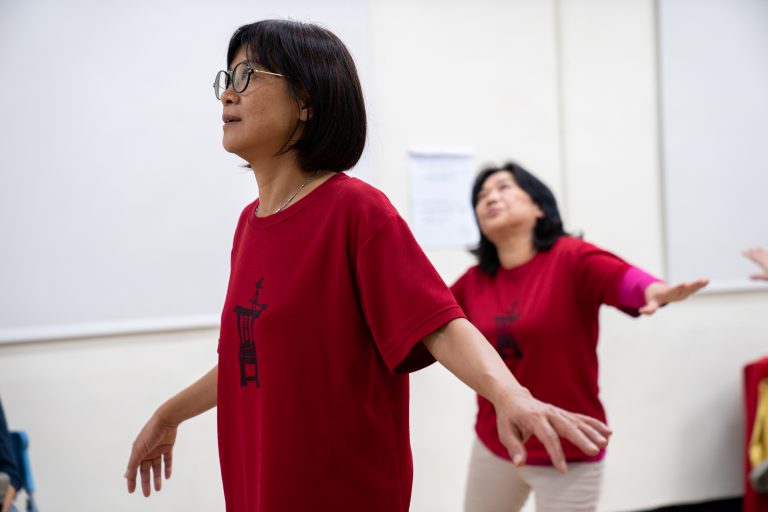 由樂齡媽媽們組成的北投女巫劇團在地方社區以「一人一故事劇場」的展演形式,為包括學生、長者、醫護人員與病患家屬等不同族群服務。圖/臺灣當代文化實驗場
由樂齡媽媽們組成的北投女巫劇團在地方社區以「一人一故事劇場」的展演形式,為包括學生、長者、醫護人員與病患家屬等不同族群服務。圖/臺灣當代文化實驗場
例如由中高齡志工、社工與社區媽媽們組成的北投女巫劇團,長期在社區為醫院病人與醫護人員、長者、偏鄉小學、精障家屬、青年族群等服務,其展演模式主要屬於民眾戲劇中的「一人一故事劇場」(playback theatre)範疇。此劇場類型由Jonathan Fox結合心理劇、儀式以及口述歷史方法所創辦,是一種以簡單又系統的表演程式來服務故事、帶著社會參與和關懷目的所發展出的互動劇場形式。其中,人際互動的對話詮釋與互為主體過程本身即為劇場展演的「田野參與觀察空間」,而與人以及其生命故事相遇的現場展演,則促使在場傾聽者與展演者集體共構出社群認同與社區支持團體。
一人一故事劇場的展演沒有既定文本、強調觀眾現場即興互動、即時演出口述內容,並藉由表演者透過肢體的轉譯表達而產生傾聽、理解與療癒的認同作用,使得包括長者經驗故事對話以及意義詮釋的「田野」動態空間,直接透過跨齡混齡的表演者在舞台上「現形」,更重要的是,展演團隊的演出,則往往因為參與觀眾的異質性、採集故事的多元性,得以發現故事與自身生命經驗的連結,因此近年來此形式也逐漸在高齡者戲劇治療與地方發展促進中高齡長輩身心靈整體健康活動中佔有一席之地。
除了將田野過程展演於舞台,在2017年OD表演工作室以高齡城市為背景的作品《老童話》,則是以實境實驗劇場的方式窺看臺灣社會未來老年想像的互動式展演作品。有別於讓長者直接在舞台上表演發聲,OD表演工作室在《老童話》中設計五個角落空間區塊作為窺看長者生活的舞台,並使用自身劇團演員演出五個老年類型角色各自的生活樣態與處境。在觀眾遊走角色生活空間與角色互動之後,則以論壇劇場的設計來引導「社區里民」討論不同角色不同處境的老後人生解方,並共同決議社區資源的協助方向。
對於《老童話》的整體設計而言,田調不只是編導與演員在籌備過程中建構地方社區特色與創作五個角色原型的基礎。更重要的是,田野調查過程作為一種社會實境體驗的設計,藉由演員展演類型角色的處境,以及主持會議者(facilitators)讓觀眾入戲成為社區里民大會成員的參與互動,深化議題討論並共同成就劇情發展方向。在「社區里民大會」的實境對話討論中,觀眾的參與形成了某種「想像的共同體」的社會展演,而其關注的面向、提出的解方、互動的過程則成為《老童話》窺看參與者共構社區在地安老價值觀的「田野現場」。
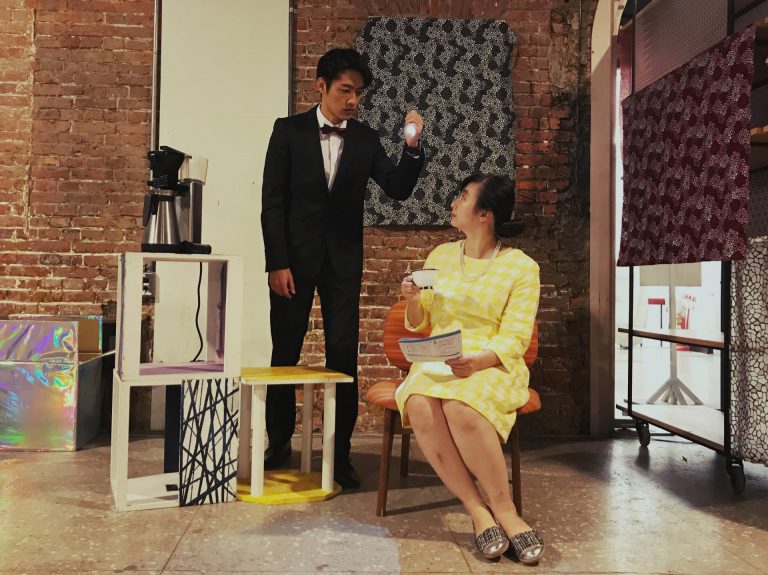 OD表演工作室的實境實驗劇場《老童話》以長者角色原型與論壇劇場的體驗,來反思民主社會對於老年族群多元需求與資源安排之間的難題與挑戰。圖/OD表演工作室陳姵如提供
OD表演工作室的實境實驗劇場《老童話》以長者角色原型與論壇劇場的體驗,來反思民主社會對於老年族群多元需求與資源安排之間的難題與挑戰。圖/OD表演工作室陳姵如提供
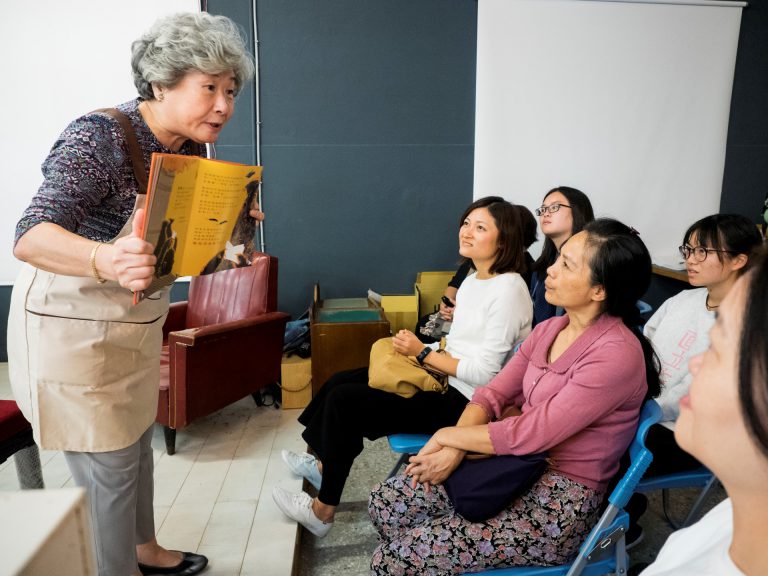 搖滾爺奶訓練爺爺奶奶以繪本故事說書,面對不同族群講述老年主題的故事,精彩的說書讓聽者入神聆聽。圖/許斌攝影
搖滾爺奶訓練爺爺奶奶以繪本故事說書,面對不同族群講述老年主題的故事,精彩的說書讓聽者入神聆聽。圖/許斌攝影
而訓練長者以繪本故事說書來參與社會的「搖滾爺奶社會企業」,則為應用戲劇展演元素創造銀髮人力價值提供了另一種可能性。搖滾爺奶有明確的「活化銀髮人力」作為目標,訓練爺爺奶奶成立說書戰隊,把咖啡廳等公開場合當作舞台,面對不同族群講述關於老後沈重主題的繪本故事,來增進自身與他人對於老年人發展潛力的可能性。
在這個模式中,爺奶必須將繪本故事轉化成為自身的展演語言,經由現場的反饋來體驗與面對真實世界對於「老」的各種觀點。扮演「說書人」角色的長者,以繪本作為媒介開啟展演空間。而說故事的互動體驗過程,則成為田野觀察的空間。從搖滾爺奶將應用戲劇與劇場元素開啟的展演空間轉化成為「田調」體驗的模式,以及說書活動強調從田野經驗中遭遇的各種「文化衝擊」窺看與反思自身老年價值觀的這個面向,不難發現戲劇與劇場元素如何轉化成為一種探索「老年文化」的設計思考工具。
透過這些案例讓我們看到,在戲劇展演作為「舞台作品」到劇場作為展演「對話過程」的視角轉變之中,展演對話的對象、目的的多元性與應用田野調查的不同模式。戲劇的「假如」(as if)創造出虛實之間的身體與空間,因此這些應用戲劇與劇場的發展模式作為田野調查的探索過程,讓眾人經歷角色扮演入戲與出戲,換位反思自身建構老年意涵的社會文化脈絡。正因為如此,戲劇與劇場作為形塑認同的儀式,不只具有「我們一起變老」的象徵意涵,同時也成為活化思考的創意以及建立或營造「田野」關係基礎的介面。
換句話說,戲劇是一個可以讓參與者透過進出角色展演,用全身思考與體現不同立場不同位置的人如何對話與互動,藉由戲劇遊戲各種對話經驗的詮釋與關照,觸發參與者創造連結的設計工具。更重要的是,應用戲劇與劇場的多元模式發展的「過程」衍生出豐富的意義與討論,則成為延展田野調查生產知識以及改變老年的社會刻板印象的方法。在劇場所呈現有關高齡議題的即興互動之中,得以進一步將展演空間的各種交集、衝突與對話脈絡化,並且藉由演員與觀眾的協力來理解自身所處的社會文化結構,在虛實之間體驗「一起變老」的意涵,進而反思自身參與社會的能動性。
事實上近年來「展演」過程的實作逐漸成為目前許多銀髮相關機構舉辦健康促進或延緩失智相關課程或活動常常會利用的模式。因為藝術性的表達經過想法的萃取精煉,是一個將故事「概念化」來發現意義的過程,作品內容充滿象徵化的符號則能夠創造更多對話空間,對參與者也會有某種「梳理」或反思人生的療癒效果。
然而,表達性藝術不只是展演文化認同與故事的靜態作品,2002年臨床心理師Jonathan Morgan即利用繪畫身體地圖作為一種藝術治療的方法。2007年即由加拿大的研究者Denise Gastaldo、Lilian Magalhães、Christine Carrasco與Charity Davy等人將此方式轉化成為一種結合口述歷史與藝術創作的故事敘說工具,用以理解多倫多移民的歷史記憶、生活空間與處境狀態。5因此,表達性藝術成為一種對話介面,其具有蒐集口述歷史資料、地方社區觀點、社會文化語言、以及創造社會連結的潛力。
而尤其,在面對高齡化挑戰之際,我們可以發現,對於高齡議題,戲劇與劇場藝術創作方法、原則與演出形式的多元性也映照出應用戲劇打破觀眾演員界線,走入社會生活「創造」展演老年對話空間的量能與特色。
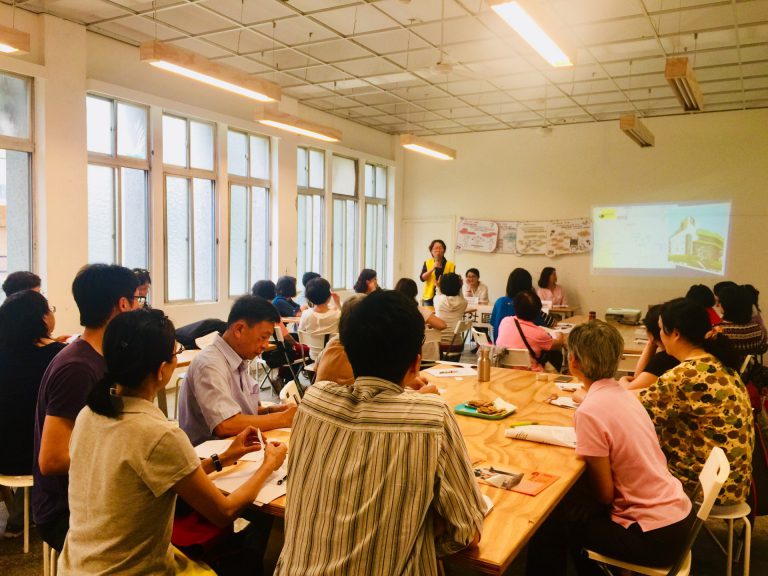 筆者在永和社區大學「創造連結:老後人生補給站」將實境實驗劇場探討長照需求與地方閒置空間活化議題的過程作為田野調查場域,以窺看參與者對於在地老化的需求與想望。圖/陳懷萱提供
筆者在永和社區大學「創造連結:老後人生補給站」將實境實驗劇場探討長照需求與地方閒置空間活化議題的過程作為田野調查場域,以窺看參與者對於在地老化的需求與想望。圖/陳懷萱提供
本文試圖指出戲劇與劇場應用作為老年社會田野觀察工具的潛力與可能性。在戲劇與人類學的交會點,我們發現戲劇方法對於民族誌資料的蒐集與產出是十分具有啓發性與生產性的工具。展演與社會的關係是筆者帶著戲劇與劇場背景走入人類學領域探索的命題,在關注「老年文化田野」之際,除了2016年底與具有人類學背景的自由教育戲劇工作者陳韻文合作開發出針對高齡照顧與服務相關人員,以戲劇形式探索社會老年多元樣貌的「劇做老年」工作坊作為同理心體驗設計的工具之外,筆者亦在社區大學「創造連結:老後人生補給站」的「社區安老一堂課」中,藉由實境實驗劇場的特性探討社區閒置空間活化與在地老化的關係,挖掘在地參與者的在地安老理想與需求。
藉由觀察目前戲劇與劇場運用田野調查探索老年文化的各種模式以及自身的實踐,筆者認為,整體而言,戲劇方法的運用成為蒐集與捲動田野資料並產生創意創新視角的一種手段。應用戲劇與劇場的「遊」、「玩」,開發即興詮釋與整合創造力以及身體感官經驗來察覺老年的多元性與洞察其需求的異質性脈絡,已經成為一種為高齡創新與創造價值的「設計思考」與「體驗設計」方法。
而從人類學的視角出發,應用戲劇「虛實整合」,在「設計思考」身體展演劇場空間的儀式中介過程使參與者看見或創造「一起變老」的社群之餘,回歸個人自身社會文化經驗,檢視日常生活感官經驗的脈絡,利用換位思考、發現與反思與他人的生活需求與想望,共同建構彼此溝通互動的集體敘事,則是應用戲劇與劇場方法可以提供不管是醫病關係或高齡化社會「創造連結」的田野對話空間。